Remote work has never been more accessible. We're seeing the next wave of world-changing companies adopting permanent remote work at an increasing rate and will only continue to grow as more companies and employees realize the advantages of remote work.
One of the main reasons so many designers and product teams are switching to remote collaboration is because of the hugely positive impact on the lives and work-life balance of employees. So much so that 97.6% of workers would like to work remotely forever, 1 in 3 U.S. employees plan to quit their job if they could no longer work remotely and nearly 1 in 2 would start looking for another job.
For people that do enjoy remote work and thrive, it's life changing
— Charles Patterson (@CharlesPattson) November 4, 2021
And it's not just great for remote workers — employers benefit from remote working too. Apart from actually increasing employee productivity, switching to a remote environment opens up an infinite talent pool. With remote work, companies can attract and hire the best talent regardless of location.
No longer are the best product design, UX design, web design, and graphic design jobs limited to designers living in expensive cities in North America. Instead of hiring locally, remote companies have access to a global remote design workforce.
In this article, we'll explore some of the challenges that come with remote design, how to cultivate a remote collaborative culture in your design team, what remote tools and best practices the best remote teams leverage, and how to find remote design jobs.

Can designers work remotely?
Given the highly collaborative nature of the design process, you might be wondering: is it even possible to design remotely across timezones? Yes — the remote job market for designers is growing fast and remote collaboration tools have made remote design work easier and more accessible than ever.
Regardless of what kind of design work you do — product design, UX design, graphic design — design is a process of solving real problems for real users. This process is collaborative by nature: you're not only collaborating with users to design the best possible solution, but you're also collaborating with different stakeholders in the design process such as other designers, developers, or product managers.
The great news is that successful remote design collaboration is all about people, not the physical spaces they inhabit. With remote collaboration tools like Figma, Loom, Slack, Miro, Zoom, Mural, and Linear, you don't need to be face-to-face with someone to strike up a meaningful conversation, come up with ideas, or collaborate on a design project. This can easily be achieved across timezones while still preserving the spirit of collaboration and facilitating more asynchronous work.
Remote companies like GitLab understand this and only hire 100% remote designers. When implemented effectively, remote companies can foster a culture of remote collaboration with both synchronous and asynchronous communication that is far more effective than traditional office spaces. They even wrote a handbook on it.
“Innovation happens when you’re intentional, and these touch points can happen in physical spaces just as easily as virtual spaces... The clearer goals, objectives, and work streams are, the easier it is for distributed teams to keep track of what others are working toward. That drives shared understanding and belonging.”
– Darren Murph, Head of Remote at GitLab
Read our guide remote collaboration best practices, challenges, and tools to learn more.

Remote design challenges and how to overcome them
According to the statistics, the overwhelming consensus is in favor of remote work becoming the new normal. No stressful peak hour commute, more time with family, and cheaper costs of living — it's no wonder that 3 out of 4 employees believe working from home is better for their mental health.
While working as a remote designer has its benefits, it also comes with some common challenges. These challenges can be particularly tricky if you're new to remote design work, or if the team hiring remote designers has only recently started doing so and hasn't established the right processes to manage a truly global design team.
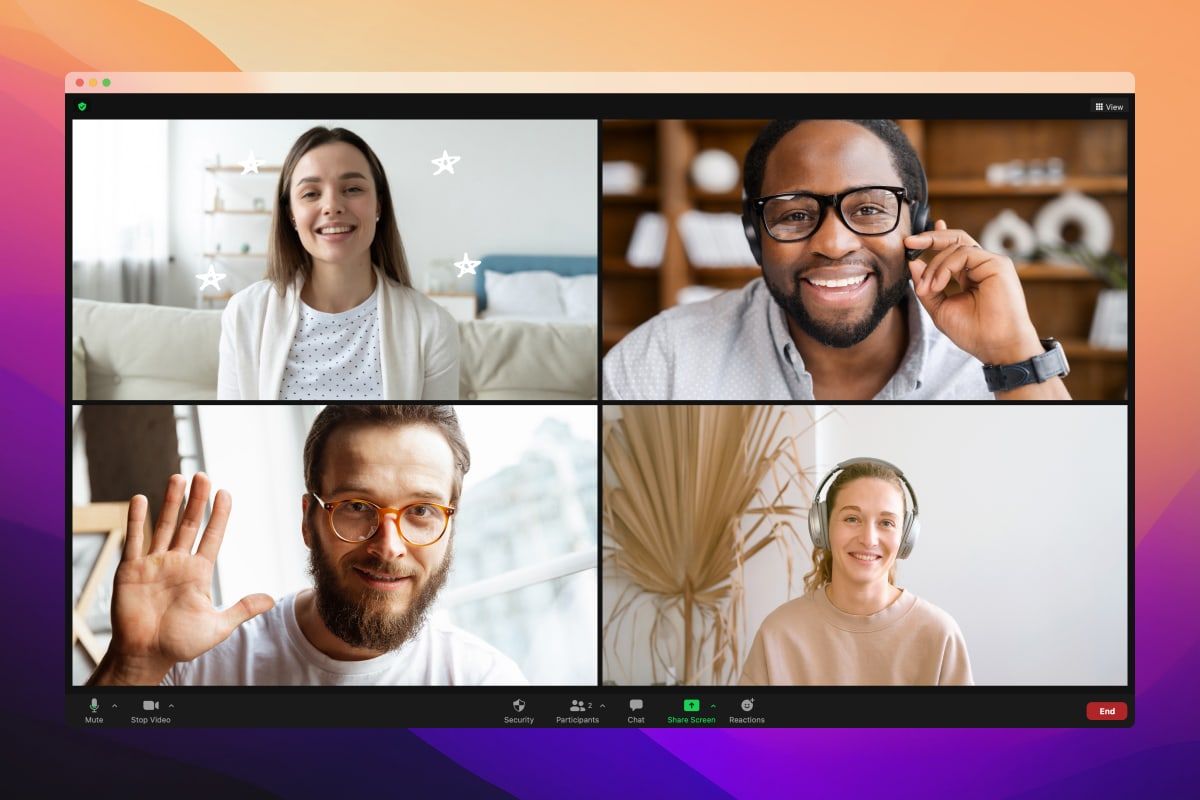
Collaboration and communication challenges
Communication is important to any team, regardless of whether they're working remotely or face-to-face. Good communication is especially important for remote design teams because of the collaborative nature of design.
One of the most common challenges when designing remotely is creatively collaborating across time zones in a distributed team and maintaining a collaborative culture. According to Buffer's 2021 State of Remote Work report, 16% of remote workers state difficulties with collaboration and communication as their biggest struggle with working remotely. If you're a small team, or in an isolated timezone, this can be even more challenging because the time difference is a significant barrier to real-time collaboration.
The best way to combat this (and a best practice for all remote teams) is to focus on over-communicating and rely on asynchronous communication wherever possible. Note: there’s a fine line between over-communicating and bombarding your team with messages, which is bad for productivity. This is where asynchronous communication comes into play.
Plan ahead for projects so you don't have to rely on video conferencing or instant messaging as much during design sprints. Instead, focus on defining project requirements as clearly as possible and default to writing and documenting your work as you go. Provide as much context as possible so your team members aren't left out of the loop.
“Being creative in a remote environment is just as feasible, though it requires more deliberate communication and benefits from a clearly defined process. In an office, lots of creativity “emerges” from teams being in close proximity. In a remote environment, the creative process must be made more explicit. But when this is done, creativity can flourish no matter the distance.”
– Abby Sinnott, InVision

A good example of this in practice is facilitating a design review. Most managers and designers make the mistake of scheduling time in everyone's calendar to go through a design via Zoom. However, this is wildly inefficient and everyone spends half the time just trying to get their head around what they're looking at. Instead, spend some time documenting your work and providing as much context with your team members as possible prior to the video chat. This is not only more efficient, but it leads to better-quality feedback because everyone has had time to consider the design asynchronously and can think more carefully about their feedback prior to the meeting. A few good points to cover:
- What are the goals of this design project?
- Are there any requirements that need to be met
- What are the constraints you’re working within?
- What stage of the design process are you at / What is missing?
- What kind of feedback are you looking for at this stage?
Of course, you'll still have opportunities to have face-to-face standups and design sprint planning sessions for more open discussions. An effective remote collaboration best practice is to allow for at least a few hours of overlap each day. This is the perfect window for video conferencing and for design team members to "catch up" and plan design sprints before continuing to work asynchronously. Most product teams allocate 10-20 minutes per day for a "standup" meeting to get everyone on track.
Working asynchronously has the added benefit of more focus time for deep and meaningful design work. When your workday isn't broken up by countless meetings and constant instant messaging, you unlock hours of uninterrupted time to focus on deep work and to iterate on designs more before presenting them to your team.
“We have people working all sorts of different hours and from all sorts of different places at Basecamp. That alone makes it hard to enforce a lot of tightly-coupled workflows during the day, but that’s a feature not a bug. Most of the work you do at Basecamp shouldn’t require you to be in constant communication throughout the entire day with someone.”
– 'How We Work' from the Basecamp Employee Handbook
Read our guide on remote collaboration for more tips and best practices.

Productivity and time management challenges
One of the great things about a remote design job is that you usually have complete control over your time. This varies from company-to-company of course, but in general remote design work comes with a flexible schedule. This flexibility and freedom are what draws many designers to remote work.
Depending on how you work, this can be a benefit or a challenge. In a traditional office environment, face-to-face design sprints, micromanagement, and intraday check-ins can be pretty common. You're also usually working next to your colleagues or manager. As a remote designer, you need to find a way of prioritizing your own tasks while staying productive and motivated.
The most successful remote designers create their own schedule and routine to keep focused and stay on task. Here are a few ways to combat this:
- Focus on deep work: Deep work, a term coined by Cal Newport, is the ability to focus without distraction on a cognitively demanding task. This distraction-free concentration pushes your cognitive abilities to their limit and creates new value, improves skills, and is hard to replicate in our world of instant satisfaction. If you're struggling with distractions and focus, block out social media, put your phone in another room, and mute notifications. It can take 20+ minutes to resume deep concentration after an interruption. Your ability to focus on deep work is arguably the most valuable remote work skill you can learn.
- Plan your day: One of the highest-leverage things you can do is to review your calendar and your to-do list at the start of the day and actually plan your day by blocking out time in your day for important work. As a designer, this may sound a little counter-intuitive because you never know when you'll be the most creative or how long projects will take. However, with a little discipline, this will force you to prioritize important tasks and to be much more intentional and efficient with your limited time. A great practice is to pick out a task you want to get done and set a clear deadline (e.g. "complete design sprint pitch deck by midday"). Even if these deadlines are self-imposed, it will do wonders for your productivity if you can stick to them.
- Focus on what is most important: Most people feel like they have an endless to-do list. When you're working across multiple design projects, this can be pretty overwhelming. The best designers over this challenge by taking tasks one at a time, picking out the highest leverage tasks they need to complete, and focusing on these first. Don't be worried about not getting everything done: if everything is important, nothing is. You may have heard of this before: the "80/20" rule or The Pareto Principle. It's the idea that 20 percent of your activities will account for 80 percent of your results. As a remote designer, this is a great exercise to prioritize your work efficiently — should you be focusing on the new product landing page launching next week or a presentation deck for the customer success team that they plan on using internally? (Hint: it's never going to be the internal deck)
- Develop a morning routine: Remote work usually affords a flexible schedule, but that doesn't mean you shouldn't set regular work hours. Establishing a consistent morning routine can have a huge impact on your time management and productivity. Aim to wake up at the same time each day, start your workday at the same time, and finish at the same time. When you get into this rhythm, it is a mental signal that you're "starting work" and need to focus. The same goes for the end of the workday, it's much easier to disconnect from work when you have the same finish time each day.

Loneliness and work-life balance challenges
When you're working in a remote design job, it's too easy for “home life” and “work life” to merge into one. This is partly because there are fewer physical barriers between home and work, and because remote work loses the real-life social interactions that spur from unplanned interactions with co-workers in the office.
Many designers new to remote work can get caught off-guard by this. When you're starting a new remote design job, it's too easy to overcompensate by working longer hours on a project, even if you don't mean to! According to Buffer's State of Remote Work report, not being able to unplug is the biggest challenges remote workers face. This can quickly snowball into other problems such as loneliness and neglect of your wellbeing — both mentally and physically.
“Finding work-life balance isn’t about prioritizing your mental wellbeing at the expense of your work. It’s acknowledging that, in the long-term, all areas of your life are better off when you put your mental health first.”
— Amir Salihefendic, founder and CEO, Doist
Thankfully, there are a few ways to help maintain a healthy work-life balance and to combat loneliness:
- Be clear when your working hours are: Clearly define and communicate when your work hours are. This is important to define for both yourself and your coworkers as it sets clear boundaries and allows others to know when you are and aren't working. A good start is to set working hours in your Google Calendar (and stick to them). When work is over, turn off notifications, set your slack status to offline, leave your computer at your desk, and get out of your home office for the day.
- Set up boundaries between work and personal life: This ties in with clearly defining work hours: try to separate your design work from your personal life by physically keeping them separate in a different room. Why? When you leave the room or your desk, it's a clear signal for your brain that work hours are over and you can relax. This extends to digital boundaries as well — turn off all or mute all notifications relating to work outside of work hours so you're not "always-on". Not being able to unplug is the most common work-life challenge faced by remote workers.
- Be proactive in reaching out to coworkers: If you're new to remote design work, you may not realize that one of the most common challenges of working from home is loneliness. 16% of workers report loneliness as their biggest challenge with remote work. There are several ways to help combat this, but one of the most effective things you can do is to proactively reach out to and engage with coworkers. Remote companies like GitLab and Doist take this a step further and organize regular one-on-ones and company retreats. You may also want to consider breaking up your week by working out of a creative coworking space — this is a great way to meet new like-minded people and socialize, while still being able to work remotely.
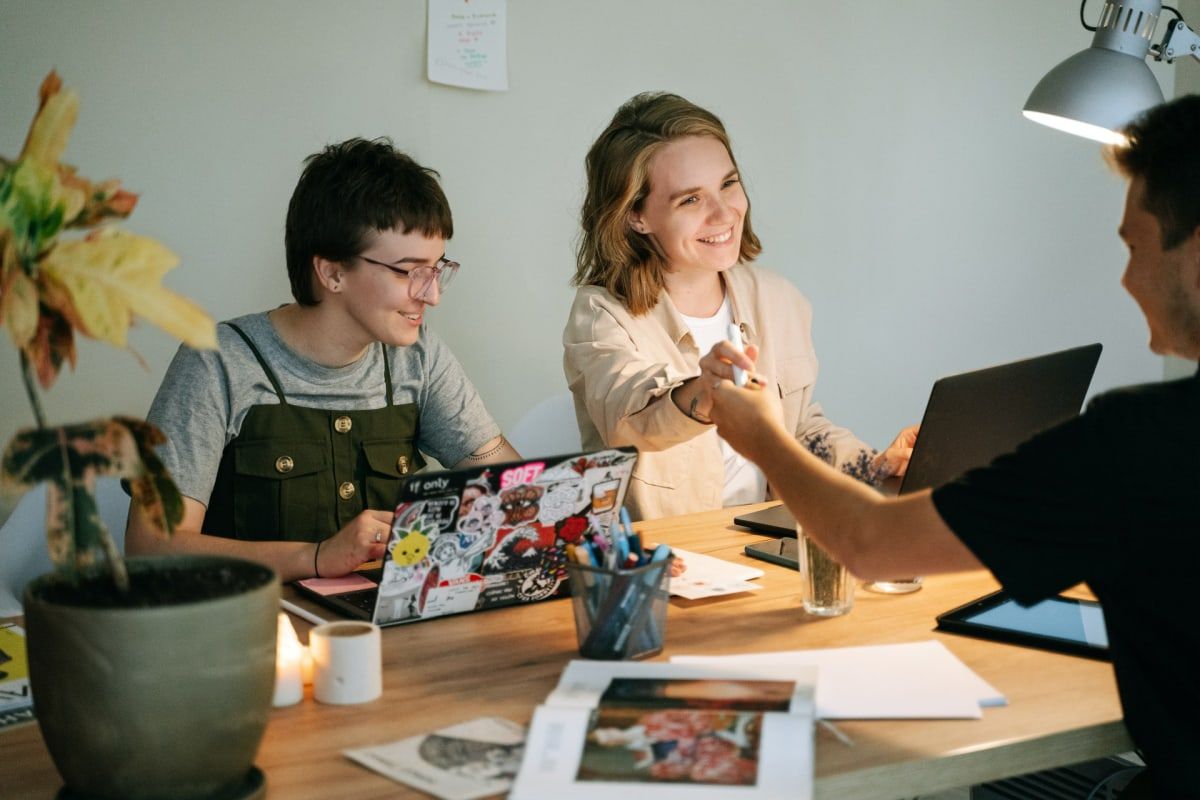
Remote collaboration tools for designers
No matter the kind of design work you do, it's important to think about how you'll adapt your design process to a remote environment. Thankfully, there are a number of remote design collaboration tools that can help make this process as smooth as possible. If you're new to remote design work, start by familiarizing yourself with these common remote tools.
When you start looking for a remote job, or are starting at a remote company, spend some time researching their tech stack and what remote tools they use to design remotely. Learning the right remote tools will set you up to hit the ground running and will be a huge plus for hiring managers when you're interviewing.

Loom
Remote collaboration is only possible with modern remote collaboration tools. One of our favorites at Himalayas is Loom, which allows you to record quick and easy video screen recordings and share them with coworkers. It's often easier to explain your points and give design feedback over video than text, particularly if you're trying to explain complex web or product design. It also integrates with Slack for an even easier sharing experience.
Loom is invaluable for distributed design teams because it facilitates visual asynchronous communication. You can't assume your co-workers understand the design project or issue as well as you do, but it can be hard to explain a design problem or roadblock when communicating across timezones via text. Recording a video explaining your design or problem is a quick and easy way to save time and headaches for everyone when they come online.
Videos recorded with Loom aren't supposed to be super polished — that's not the point. Instead, they're rarely more than 5 minutes long and it doesn't matter if they contain mistakes. They're almost like presenting in person, except unlike video conferencing, your team can watch, re-watch, and provide feedback when it's convenient for them. This form of asynchronous communication is incredibly valuable for remote design teams.

Slack
Slack is a popular instant messaging app that is used by thousands of remote companies around the world as their primary communication channel. Think of Slack like the office "water cooler". Most design teams use Slack to coordinate and discuss projects, but when not managed properly, it can become a huge distraction.
For Slack to work well in remote design teams, it needs to be treated as an asynchronous tool where you don't need to respond instantly. Otherwise, it can become extremely distracting. If someone sends a message and you're expected to respond in near real-time then you're not operating in an async environment.
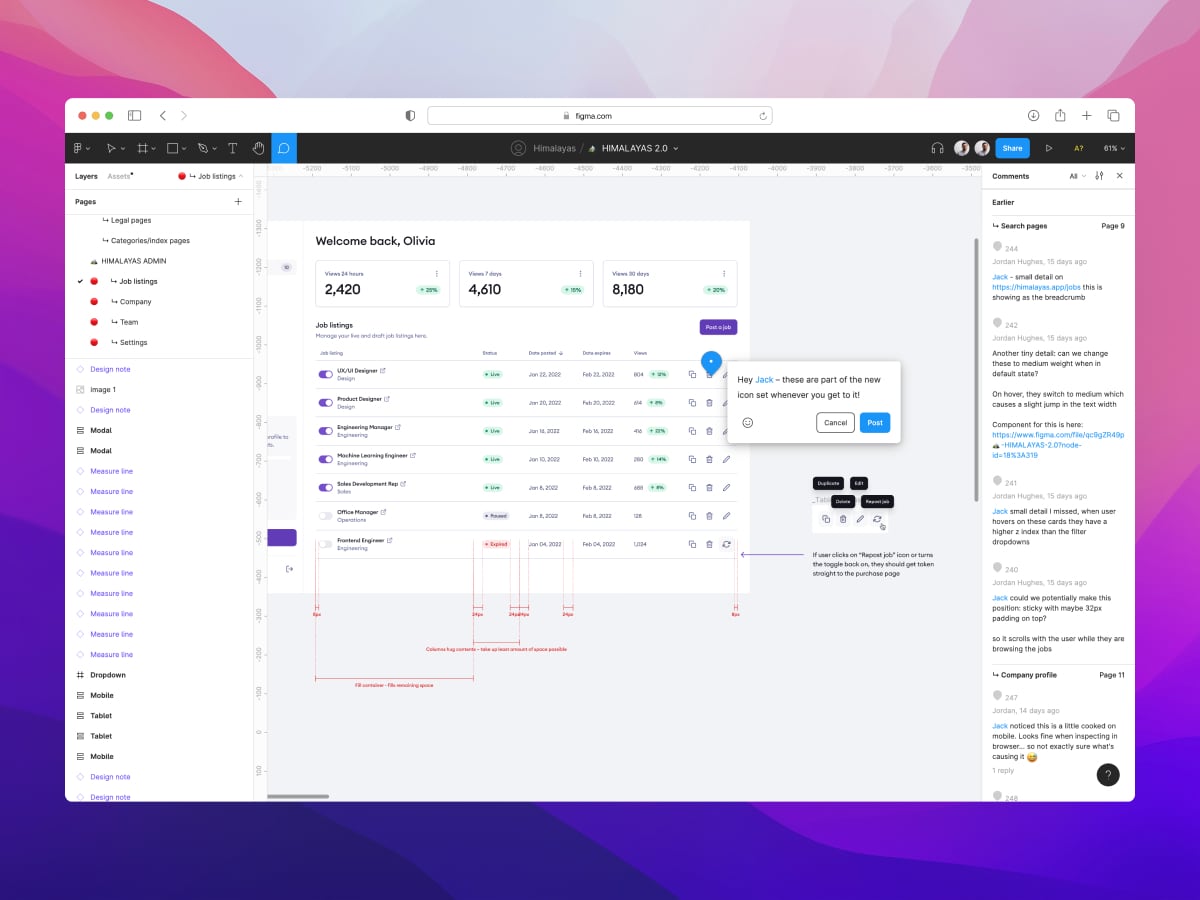
Figma
Figma is a collaborative design tool enabling remote teams to create beautiful software from anywhere in the world. As a tool primarily for UX design, they're always looking for UX designers and product designers, but are always hiring across all disciplines.
Why there are dozens of similar design tools available (other popular alternatives include Sketch and Adobe XD), the core insight of Figma is that design is larger than just designers, and collaboration and iteration are the keys to success. Modern design is an accumulation of all of the collaboration between designers, product managers, and users.
Figma launched with a value proposition primarily around making design collaborative and browser-based, so designers could work together more easily. They could even work on designs at the same time. Today, it's the most powerful and user-friendly tool for remote designers to leverage and design world-class products. It also includes powerful prototyping features built-in, so you can build interactive examples of your designs to get developers on the same page faster.
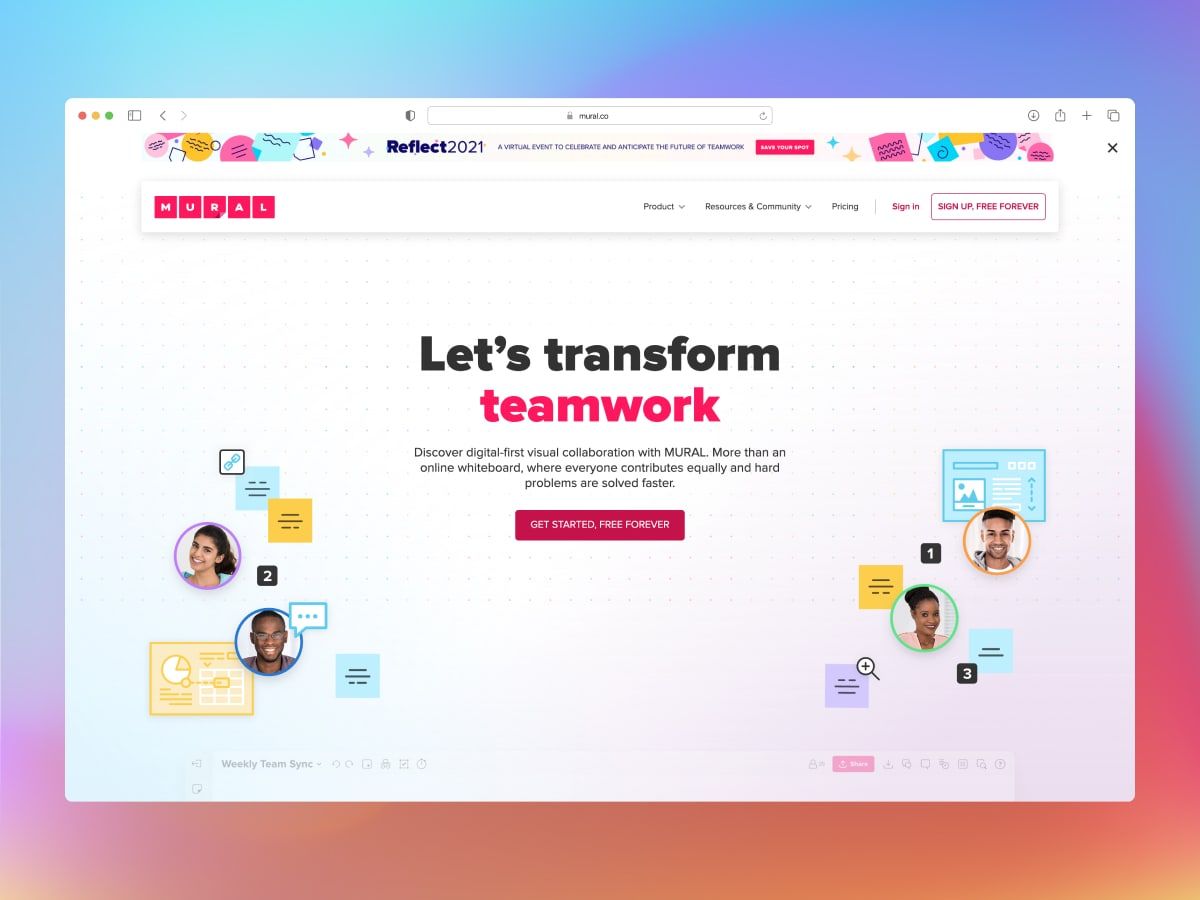
MURAL
MURAL is a digital workspace for visual collaboration. A good way to think about their software is as a digital whiteboard, where remote designers and stakeholders can imagine together to unlock new ideas, solve hard problems, and innovate faster.

Miro
Miro (formerly Real Time Board) is an alternative to Mural that is growing in popularity. It's a great tool for remote teams to collaborate visually on ideas, projects, and designs. Both tools are easy-to-use and perfect for facilitating online collaboration and virtual workshops, but one of the main differences between the two is Miro has a wider range of integrations.

Zoom / Google Meet
Zoom and Google Meet are invaluable when it comes to synchronous communication. No longer do you need to be physically face-to-face with someone to strike up a meaningful conversation.
Most remote design teams and companies use some form of video conferencing tool to collaborate, even if they mainly work asynchronously. According to Basecamp, "Working remotely, if it is to be successful, usually requires some overlap with the hours your coworkers are putting in...we've found that we need a good four hours of overlap to avoid collaboration delays and feel like a team."
As part of a remote design team, you'll likely use video conferencing tools for daily standups, design critiques, design sprint planning, and manager 1-on-1s, so it's important you're familiar with them. You might even want to consider upgrading your home office with a high-quality webcam and microphone.

Linear
Linear helps streamline software projects, sprints, tasks, and bug tracking. It's built for high-performance teams. At Himalayas, we use Linear to manage our software development. It helps remote teams collaborate on projects asynchronously and is incredibly easy to use.

20 companies hiring remote designers
Below are 20 great companies that often have remote opportunities for UX design, product design, graphic design, and web design.

MURAL
MURAL is a virtual collaboration platform on a mission to inspire and connect imagination workers globally. Used by thousands of design and product teams around the world, they're growing fast and are a global team of 850+ workers all around the world.
MURAL are always looking for great designers, and are hiring for dozens of design roles.
Recent remote work from home design jobs at MURAL:
- Product Designer – Design System
- Product Designer – Accessibility
- Design Program Manager
- Web Designer
Learn about MURAL, MURAL's tech stack, or find remote jobs at MURAL.

Webflow
Webflow is a powerful design tool that allows anyone to create professional, custom websites in a completely visual canvas with no code. If you haven't used Webflow before, it's a great asset to have as a designer and allows you to bring designs to life without relying on expensive and slow developers.
Webflow is a global team and growing incredibly fast. They're usually hiring across several different remote design roles but mainly recruit talent from the US.
When I think about the people I get to work with at @webflow, I truly believe I’ll work with many for the rest of my career.
— David Hoang (@davidhoang) December 24, 2020
Looking back, you remember the small moments. Where we will end up is unwritten and I’m simply enjoying the moment.
Recent remote work from home design jobs at Webflow:
- Senior Brand Designer, Creative
- Product Design Director
- Senior Motion Designer
- Product Designer
Learn about Webflow, Webflow's tech stack, or find remote jobs at Webflow.

Braze
Braze is a comprehensive customer engagement platform that delivers messaging experiences across push, email, in-product, and more. They're on a mission to help companies create memorable experiences between consumers and the brands they love.
They're a team of 900+ remote workers with offices all over the world and truly value good design. It doesn't look like they're slowing down either, and are usually hiring for dozens of product and design roles.
Recent remote work from design jobs at Braze:
- Director, Product Design
- Senior Instructional Designer
- Lead Product Designer
- Senior UX Researcher
- Product Designer, SMB
Learn about Braze, Braze's tech stack, or find remote jobs at Braze.

Superside
Superside is an always-on remote future-of-work design company that delivers hassle-free design at scale to 350+ businesses including Facebook, PUMA, Amazon, Shopify, Kiva, and more.
They are a super interesting startup that works together in teams with companies through their own DesignOps platform, enabling seamless collaboration and efficient work across all time zones.
Superside are growing fast and always looking to recruit the best designers around the world, now spanning 50+ countries with 400+ employees.
Recent remote work from design jobs at Superside:
- Graphic Designer
- Illustrator
- Creative Director
- UX/UI Designer (Web)
- Design Directors
Learn about Superside, Superside's tech stack, or find remote jobs at Superside.

Help Scout
Help Scout is a popular customer support email and live chat platform on a mission to “empower businesses with tools that serve people in the most human, helpful way.”
Founded in 2011, Help Scout has been a fully remote company for over a decade and is powering 12,000+ teams in 140+ countries. Their 150+ distributed team is spread across 80+ cities worldwide.
“We're remote. It doesn’t matter if you’ve worked remotely before — we’ve been doing it for nearly a decade and are helping to write the playbook — we’re happy to show you the ropes. Most folks that get a taste of working in a "remote first" company have a hard time going back to the old way of doing things.”
Recent remote work from home design jobs at Help Scout:
- Product Designer
- Brand Designer
- User Researcher
Learn about Help Scout, Help Scout’s tech stack, or find remote jobs at Help Scout.
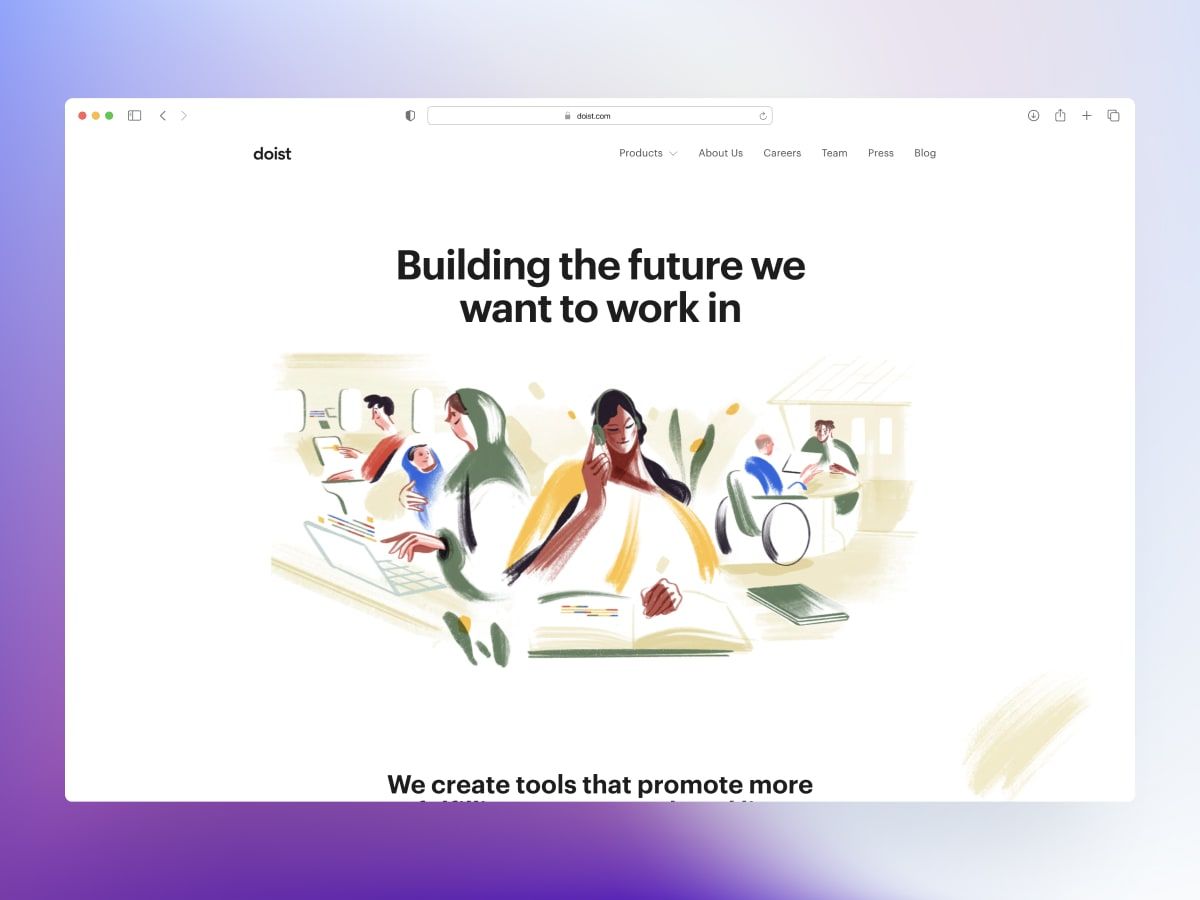
Doist
Doist does productivity software really well. They create tools for individuals and teams that simplify and organize the workday, notably Todoist and Twist. With over 60 employees across 51 cities, the Doist team operates as a remote-first company and is 100% bootstrapped.
We’re huge fans of Doist because they’re vocal advocates for remote work, asynchronous work, and do their part to give back. Part of being a remote company means being responsible citizens of the world. Every year, Doist donates up to 2% of revenue growth to support internationally-minded organizations. They’re one of the reasons at Himalayas we contribute 10% of every payment to remove CO₂ from the atmosphere with Stripe Climate.
Doist is clearly doing something right, with an incredible retention rate of 98.5%, and more than 50% of employees staying with the company for over four years.
“A product stands a better chance of resonating with a global workforce when it’s created by people around the world.”
— Amir Salihefendic, Founder and CEO, Doist
Recent remote work from home design jobs at Doist:
- Product Designer
- Illustrator
- Brand Designer
Learn about Doist, Doist’s tech stack, or find remote jobs at Doist.

Monograph
Monograph is an architecture tool modernizing design professionals’ back office with a beautiful, data-driven platform to help them manage, plan, and grow their companies. They're on a mission is to let architects get back to doing what they love and do best—design—not finance, management, or Excel.
They have an absolutely stunning marketing site and obviously care about the design of their product. That's a good sign if you're looking for a remote design job!
Recent remote work from home design jobs at Monograph:
- Sr. UX Researcher
- Sr. Product Designer
- Web Designer
Learn more about Monograph, Monograph's tech stack, or find remote jobs at Monograph.

Loom
Loom is on a mission to empower everyone at work to communicate more effectively and get ahead, wherever they are. Loom is one of our favorites at Himalayas because it allows you to record quick and easy video screen recordings and share them with coworkers.
Loom is used by 12m+ users and 200k+ companies and cares deeply about design. Check out their beautiful marketing site if you haven't!
Recent remote work from home design jobs at Loom:
- Senior Product Designer, Create
- Product Designer, Growth
- Director of Design
- Illustrator
Learn about Loom, Loom's tech stack, or find remote jobs at Loom.

Square
Square is a financial technology company started by Twitter co-founder Jack Dorsey. They help millions of sellers all around the world accept payments and run their businesses, from EFTPOS machines, secure card payment processing, to eCommerce stores. We love Square because they're breathing new life into commerce and financial tech, with a particular focus on small businesses. Most incumbent players in this space are expensive, ugly, and hard-to-use but Square builds tools to make starting and running a business affordable, seamless, and easy.
Square employs over 4,000 people all around the world and has offices around the U.S., as well as in Dublin, London, Toronto, Melbourne, and Tokyo. They're growing fast as well and are hiring for exciting growth in 2022. They're always hiring for dozens of remote design jobs.
Recent remote work from home design jobs at Square:
- 3D Motion Designer, Cash App
- Lead Product Designer
- Lead UX Researcher
- Content Designer
- Brand Designer
- Senior Art Director
Learn about Square, Square's tech stack, or find remote jobs at Square.
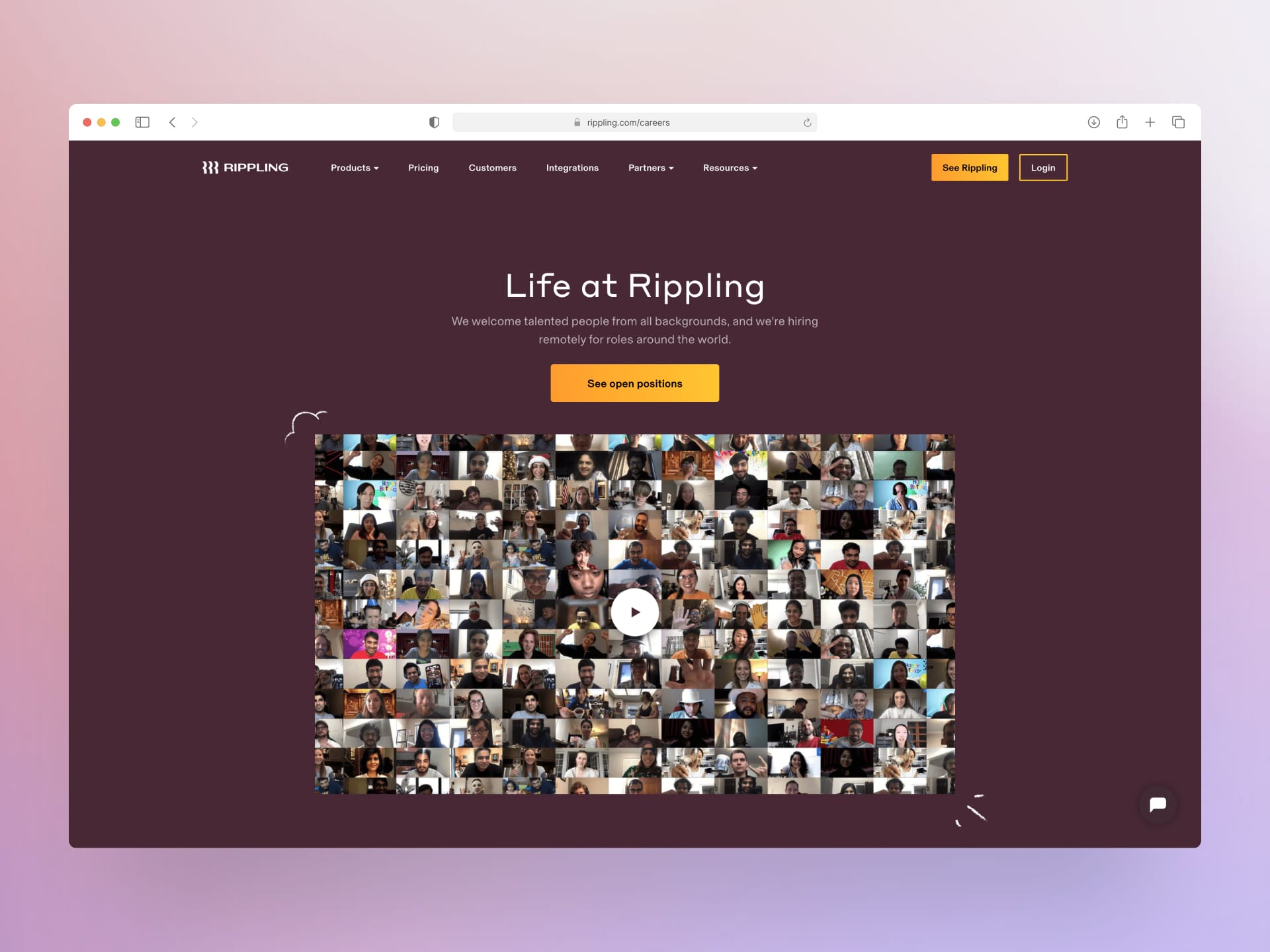
Rippling
Rippling is a HR & IT management tool founded in 2018. They help companies manage employees more efficiently all in one, modern system.
In just a few years, they've raised $450m+ and grown to 750+ employees globally! But they're not slowing down — they're hiring for dozens of roles, including a bunch of product designer and UX designer roles.
Recent remote work from home design jobs at Rippling:
- Director of Product Design
- Product Designer
- UX Researcher
Learn about Rippling, Rippling's tech stack, or find remote jobs at Rippling.

Lattice
Lattice is a people management platform used by 2,750+ companies around the world to help employees perform their best. They have offices in San Francisco, New York City, and London, but are also a distributed team and are hiring across many roles remotely.
They launched in 2016 and are growing incredibly fast, counting great companies including Slack, Pinterest, Monzo, Reddit, and Asana as customers. They also deeply care about design. Their marketing site is one of our favorites at Himalayas!
Recent remote work from home design jobs at Lattice:
- Webflow Designer
- Brand Design Lead
- Senior Product Designer
- UX Researcher
Learn about Lattice, Lattice's tech stack, or find remote jobs at Lattice.

ConvertKit
ConvertKit is simple email marketing software for online creators. With 19,500 paying customers sending 500 million emails per month, ConvertKit are 100% independent, 100% remote and are growing rapidly.
They’re also a 100% remote team of 65+ people in 50+ cities. ConvertKit “hire A-players and treat them like A-players because we believe in the power of great company culture to help us grow”.
“Being a fully remote team we’re a highly motivated bunch of people, and many of us are creators ourselves running various side projects in our spare time.”
Recent remote work from home design jobs at ConvertKit:
- Brand Designer
- Product Designer
Learn about ConvertKit, ConvertKit's tech stack, or find remote jobs at ConvertKit.

Pitch
Pitch creates beautiful collaborative software for making and sharing beautiful presentations. Their easy-to-use platform combines the best parts of productivity, design, and presentation software to help fast-moving teams create beautifully designed decks in minutes.
They started in 2018 and are growing incredibly fast as more and more companies all around the world make the switch from Google Slides and dusty old Powerpoint. They're a remote-first team of 120+ and are always looking for talented designers.
Recent remote work from home design jobs at Pitch:
- Product Designer, Data Visualization
- Visual Designer
- Senior Motion Designer
- Senior Product Designer
Learn about Pitch, Pitch's tech stack, or find remote jobs at Pitch.

InVision
InVision is the Digital Product Design platform used to make the world’s best customer experiences. They provide design tools and educational resources for teams to navigate every stage of the product design process, from ideation to development.
Design has never been more important in business, in culture, and in the world than right now. InVision are big advocates for the value of design and are always hiring across different remote design jobs.
Recent remote work from home design jobs at InVision:
- Lead Design Researcher
- Product Designer
- Illustrator
Learn about InVision, InVision's tech stack, or find remote jobs at InVision.

Spline
Spline (twitter.com/splinetool) is an exciting new design startup founded by Alejandro Leon in 2020. They are building a design tool to create 3d content for the web.
3D design is traditionally a complicated process, but Spline is making it easy to build and iterate fast with production-ready results.
Naturally, Spline are a remote company and are growing fast — they're usually hiring for design roles to help grow their product.
“We are passionate about building visual tools and solving creative challenges.”
Recent remote work from home design jobs at Spline:
- Senior 3D Designer
- Senior Product Designer
Learn about Spline, Spline’s tech stack, or find remote jobs at Spline.

Hotjar
Hotjar is a powerful user analytics and behavior tool used to help teams improve their website and convert more visitors. Their software is trusted by almost a billion websites in 180+ countries and used by thousands of UX designers, product managers, and user researchers.
Hotjar is a 100% remote company and 100% self-funded. Today, they employ over 200 remote workers throughout the Americas, Europe, Africa, and Asia. They’re also big fans of asynchronous work and autonomy: “We hate bureaucracy and slow-moving organizations – but we're suckers for well-defined processes.”
Recent remote work from home design jobs at Hotjar:
- Product Designer
- Senior Brand Editor
- Web Designer
Learn about Hotjar, Hotjar’s tech stack, or find remote jobs at Hotjar.

Contra
Contra is a professional community for digital nomads and independent workers, helping thousands of people around the world balance work-life, creativity, and professional freedom.
They’re a 100% remote company and are hiring fast to “help build the future of work, from wherever you choose!” They care deeply about design and have a stunning website.
Recent remote work from home design jobs at Contra:
- Product Designer
- Brand Designer
- Graphic Designer
Learn about Contra, Contra’s tech stack, or find remote jobs at Contra.

Upwork
Upwork is one of the world’s largest distributed online talent marketplaces. With matching technology, startups to Fortune 500 companies have access to a global pool of proven professionals so they can scale quickly and dynamically. Think of Upwork as a huge marketplace of high-quality freelancers.
Upwork began over two decades ago by pioneering a better way of working and has been remote from day one. Their mission is to “create economic opportunities so people have better lives.” Their huge remote workforce benefits from unlimited PTO, health insurance, and remote and wellness allowances.
“As a remote-first company, we understand that just because your workstation is at home doesn't mean you're always on-call to work. Our leaders encourage employees to take their PTO and to set schedule boundaries.”
Upwork has invested heavily in design recently, and have a beautiful new brand and website. They're still growing fast and always hiring for dozens of remote roles.
Recent remote work from home design jobs at Upwork:
- Product Designer – Payments
- Senior Design Recruiter
- Product Design Manager
- Senior Graphic Designer
Learn about Upwork, Upwork’s tech stack, or find remote jobs at Upwork.

Stripe
Stripe builds financial tools and economic infrastructure for the internet. Millions of businesses rely on Stripe’s software tools to accept payments, expand globally, and manage their businesses online.
If you're interested in design, you're probably aware of the design influence Stripe has on the internet. Known as the "the Stripe effect", their website designs are so well-renowned in the design industry that whenever a new version launches, heavily-influenced sites start to pop up around the web.
Recent remote work from home design jobs at Stripe:
- Brand Designer
- Product Designer
- UX Researcher
- Visual Designer
Learn about Stripe, Stripe's tech stack, or find remote jobs at Stripe.

Wealthsimple
Wealthsimple is a Canadian investment management platform focused on helping millennials. They make powerful financial tools to help you grow and manage your money.
Recent remote work from home design jobs at Wealthsimple:
- UX/UI Designer
- Brand Designer
- UI Researcher
Learn about Wealthsimple, Wealthsimple's tech stack, or find remote jobs at Wealthsimple.

How to find and get hired for remote work from home design jobs
If you're interested in work from home jobs in UX design, product design, web design, or graphic design, be sure to check out post on the best remote job boards that outlines over 70 of the best places find remote job postings.
If you just want to search the best remote job board, check out Himalayas.
Before applying for remote design jobs, remember to read the job description carefully. It's also worth spending some time updating your personal design portfolio or website with more recent work, particularly if it's relevant to the job you're interested in.
For more tips, read our posts on how to find a remote job and get hired and essential remote work skills.
If you get an interview, be sure to read our posts on the best questions to ask in an interview and common behavioral interview questions you should prep for. We also recommend using the STAR method to ace your behavioral job interview. It'll also be important to have a quiet place to take the interview (and work) like a dedicated home office.







